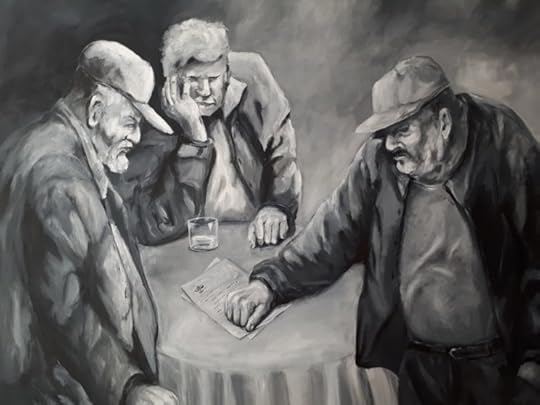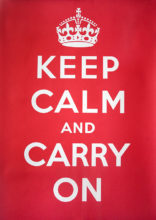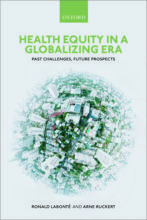Oxford University Press's Blog, page 149
May 13, 2020
The words of the day
The readers of newspapers will have noticed the deadening repetition of the same words (I don’t mean pandemic, virus, distance, or opening—those are probably unavoidable). No, everybody nowadays hunkers down (the activity formerly reserved for the greatest leaders at their secret meetings), while many admire Sweden, where people trust their government (the Swedish ambassador to the United States has even written an article about it for Los Angeles Times), and so forth. Hunkering down—yes, I understand, but people trusting their government and one another?! What are they up to? I think I should say something about the origin of trust, even though I have a vague recollection that I have already done so. In any case, the one word that needs our immediate attention is snitch. Enthusiastic citizens vent their wrath on the malefactors who walk unmasked in public (that is, show their true face), and snitch on them. Others warn us of the dangers of totalitarianism and curse the enthusiasts. Now, snitch means “a (police) informer, someone who rats on others.” I’ll keep my feelings about snitches to myself, but, true to the goal of this blog, will devote some space to the word’s etymology, the more so as dictionaries state with an unusual degree of unanimity that the origin of snitch is “uncertain,” while I believe that it is almost certain.
 Unwilling to show his true face. Photo by Ashutosh Sonwani from Pexels.
Unwilling to show his true face. Photo by Ashutosh Sonwani from Pexels.By the way, the phrase “origin uncertain” is deceptive, because everything hinges on the degree of uncertainty. Did the word appear from nowhere and despite all our endeavors is doomed to remain in limbo? Or do we know something about the word’s derivation but not enough to draw reliable conclusions about its etymology? Or, finally, have several ideas been proposed, none of them sufficiently convincing? We will see below that the verdict about the obscurity of snitch is due to excessive caution.
Old books tell us that murderers tend to return to the place of their crime. Is it a romantic legend? Modern criminals roam freely, show no signs of nostalgia, and may not be caught until someone, lured by an offer of a huge sum of money, snitches on them. But I, though perfectly innocent, do often return to my favorite haunts. One of them (in the context of this essay) is the sequence of posts devoted to the derivation of sn-words. In the past, I have discussed sniff, snuff, sneeze, snout, and snob (see the posts for May 14, 2008; May 1, 2019, and May 8, 2019).
 A sleuth and a snitch. Image by shootelkora from Pixabay.
A sleuth and a snitch. Image by shootelkora from Pixabay.While reading the sn-pages of an etymological dictionary, one keeps running into the same statement: “Of Dutch or Low German origin.” Dutch sources have relatively little to say about the words in question. Hardly any one of them is bookish: cf. snaffle, snap, snarl, snack, sneak, sneer, snick, snip, snot, and snug. Some are borrowed from Scandinavian or “of unknown origin.” Some such coinages must have been sound-imitative, expressive, perhaps slangy, or even vulgar. They engendered one another (like snout and snot, snore and snort; snite and snipe, both meaning “snatch”), referred to the nose (like sneeze), or coined to offend (snub and snob). A sn-word degrades its bearer. For example, Swedish snok ~ Danish snog mean “sleuth” (nearly the same as snitch!), and several similar Scandinavian nouns refer to apple polishers, toadies, and all kinds of parasites.
Old Engl. snican meant “to creep”; its counterpart in Icelandic had long i (sníkja). Modern Engl. sneak (known since the sixteenth century), with its present-day root vowel, can be traced to a form with neither short nor long i. Perhaps all three were coined more or less independently, but the impulse that inspired their creators must have been the same. Snake is an old word, with cognates elsewhere in Germanic and Celtic. Its modern congeners in Swedish and Danish are snok and snog (they mean “garter snake”). But we have already seen both! The most authoritative old Scandinavian etymological dictionary states that they are not related pairwise. Perhaps they are not, but their similarity is astounding. After all, snakes do creep, and the animal name seems to owe its origin to the same mental process that gave us many of its look-alikes. It will be remembered that refences to snakes are seldom complimentary.
 Everything depends on the degree of uncertainty. Doubt, public domain via pxfuel.
Everything depends on the degree of uncertainty. Doubt, public domain via pxfuel.Fortified by the examples cited above, we can examine snitch. It appears that the clue to its origin is provided by snatch, despite the chronological gap between them: snatch has been known in English since the sixteenth century, while snitch surfaced in an English text in 1676 (so the OED) and meant “a fillip on the nose.” In 1785, snitch “police informer” surfaced in a slang dictionary. There can be no certainty that we are dealing with the same word: snitch might have been coined twice (compare the doubts about the difference between Scandinavian snok/snog1 and snok/snog2), but they probably belong together. Snatch is a rather obscure doublet of snack, but the great Norwegian scholar Sophus Bugge pointed out as early as 1874 that the Swedish cognates of Engl. snatch, even though they too have the vowel a in the root, mean “to steal small things.” It is the reference to the small size of the purloined objects that may be important. After all, a fillip is a small flip, and a snitch is a petty operative.
 A “snatch” as the parent of “snitch”? Münster’s sights and views. Public domain via Wikimedia Commons.
A “snatch” as the parent of “snitch”? Münster’s sights and views. Public domain via Wikimedia Commons.As has been known for a long time (and I have often referred to this fact), the vowel i, as in sip, tip, pick, tends to evoke the idea of smallness. In words like pit-a-pat, trictrac, wigwam, whippersnapper, wishy–washy, and so forth, the first component always contains short i and “progresses” to a more open vowel, usually a. Compare also snip and snap, flip and flap. Snitch seems to be a diminutive version of snatch. To be sure, the semantic range of all such words is broad. Their senses are fluid and sometimes mutually exclusive. For instance, the noun snatch, known since the fourteenth century, has been recorded with the meaning “catch, hasp; trap, snare; snack” and “small amount.” But in comparison with snitch, snatch looks big! Thus, I would like to propose that a snitch a diminutive snatch (think of “trap” and “catch”). I cannot prove my hypothesis (etymologies can seldom be proved the way mathematical theorem are), but, to my mind, it looks reasonable and at least more inspiring than the cautious verdict: “Of uncertain origin.” Uncertain indeed: no respectable Indo-European root, no foreign form of which it can be a borrowing, no recorded name of the word’s inventor. But such are most sn-words, those products of “vulgar” creativity that, nevertheless, feel perfectly at home among our most “respectable” nouns, adjectives, and verbs.
Feature image credit: Image by tdfugere from Pixabay.
The post The words of the day appeared first on OUPblog.

How children going viral is shaping our world
Last year my seven-year-old daughter came home from school and “flossed” in the middle of our lounge room. For the uninitiated (as I was) and for the oldies (as I am), flossing is not your average teeth-cleaning ritual, but “a dance in which you move your hips from side to side while simultaneously moving your hands through the air in the opposite directions as if holding on to the hips of a woman.”
If you can’t quite visualise how the everyday routine of dental flossing becomes a dance, 15-year-old Savannah’s YouTube tutorial caters to those of us less in the know. “Yes it’s that dance your kids always do, but you can’t seem to master,” pokes – and jerks – Savannah. And Savannah is right. The awkward, jolty moves demand something that is beyond my body’s capacities for arrhythmic coordination. Watching my daughter floss jerkily from side to side, I wondered: who is this flossing child before me?
In the midst of COVID-19, there has never been a more compelling moment to think about how expressions of childhood move through culture. There has never been a more urgent time to reflect upon what it means to be – what I have called before this pandemic – a viral child. In 1994 media theorist Douglas Rushkoff coined the metaphor ‘viral’ media to describe the rapid spread of digital content across media platforms. In the compromised context of COVID-19, the concept of viral media is exceptionally acute as we repurpose and stretch existing media frameworks to fit the circumstances of a virus pandemic and a globe in isolation.
Young people are already the drivers of viral content, although now the circuits between the live and the digital are being domestically contained. When dance moves such as the floss would normally move between dance clubs and TikTok, street spaces and YouTube, or playgrounds and Twitter, the limiting circumstances of home isolation, rather than restricting innovation, only seem to increase it. Comical, goofy, parodic responses show us that movements are still on the move in infinitely shareable, infinitely commercial, possibly radical – and yes – culturally unprecedented ways, from classroom antics to TikTok mashups.
Last year’s precedents in youth activism have had a large role to play. Youthquakes took place around the globe; students stormed the streets and young speakers showed mastery in rhetorical from. In a global first, the Time Person of the Year was none other than Greta Thunberg, a child. And in Australia, our TVs were startled by the footage of youth activist #Eggboi upstaging a press conference to egg an Australian senator in the head for racism. These movements point to the eco-political as well as digital contexts in which contemporary childhoods take place. They occur despite prevailing perceptions that children should be kept out of politics.
In the context of COVID19, the digital life of a viral child produces a set of performance frameworks that position children’s voices and gestures centre-frame. These are scenes that position the child as a self-constituting, self-generating part of the total image-sphere. They depict children as agents of their own representations. It seems that children are commanding the screen, the scene, the message.
Where the haphazard eruption of a lounge room floss might seem small and insignificant – what might be interpreted as nothing more than a minor representation – it also reflects major structural, social and economic shifts. It arrived in my house as an embodied expression of the multiple sharing economies with which young people’s identifications are built. But it also shows us that the changing nature of childhood transforms the function and reach of media platforms, and that both are building new types of audiences and markets.
We can think about these expressions as new forms of literacy that change who controls how communication takes place. They are radical because they stage within the body a knowledge of movement’s power, of its rhetorical and political potency to move. They teach the body what it feels like to act together – even at a distance – and how that form of collective action can lead to tangible change.
Children, as the symbols as well as generators of these evolving forms of communication, are instrumentally shifting how their agency – cultural, political, and economic – is being put to work. Being a viral child suggests that both youthquakes and pandemics are equally possible, often interconnected, circumstances. Being a viral child means that is not possible to operate from outside of these domains and the thorny ambiguities that they stage. It is rather a way of navigating and transforming the paradigms within which the voices, moves and self-expressions of young people are made to appear – and hopefully, to count.
Featured Image Credit: Media-Social-Apps via Pixabay.
The post How children going viral is shaping our world appeared first on OUPblog.

May 12, 2020
The life and legacy of Florence Nightingale [timeline]
This year, to celebrate the role nurses and midwives play in providing health services across the world, the World Health Organisation has declared that 2020 is the International Year of the Nurse and the Midwife. In honour of this, we are taking this opportunity to recognise the work of Florence Nightingale, a British nurse, statistician, and social reformer.
From her early years of training to be a nurse, to her work in improving healthcare for the British Army in India, discover the story of the founder of modern nursing.
Featured Image Credit: by FormerBBC via Wikimedia Commons
The post The life and legacy of Florence Nightingale [timeline] appeared first on OUPblog.

Envisioning a post-crisis world
Early in World War II, in August 1941, before the United States had entered the war and Britain stood alone against Adolph Hitler, President Franklin Roosevelt and Prime Minister Winston Churchill steamed in secret aboard their respective battleships and met off the coast of Newfoundland on HMS Prince of Wales. Their aim: Shape the Post War World. They drafted eight points that became the Atlantic Charter, shaping the United Nations and other lasting relationships of the post-war years.
Humanity, 7.8 billion of us, now faces what may be an even larger crisis than World War II. Perhaps for the first time in our 300,000 years of existence we are aware we are a single species in which COVID-19 swarms. Our $100 trillion global economy growing at 3% a year is lifting millions from poverty, links our nations in trade, is the means by which we earn our livings and find much of our meaning. But the same juggernaut growing economy is driving climate change, a mass extinction, and wave after wave of pandemics as we invade habitats: Zika, SARS, Ebola. We are destroying the biosphere of which we are children.
This pandemic is not an accident. Almost certainly it is we who have caused it. 300,000 years of our cumulative technological, and cultural evolution proceeded at a glacial pace for tens of thousands, then thousands, then hundreds of years, then burst upward in the last two centuries.
GDP and per capita GDP fluctuated at about $400 for thousands of years then exploded upward, shown in the figure below. Before that per capita GDP explosion, humanity was in a Malthusian trap. If population went up, resources did not. We died back. With that explosion, where per capita GDP rose faster than the population could expand, the population rapidly increased to our present 7.8 billion. We are beyond the Malthusian trap. We are now creating another, worse, and perhaps final trap.

We begin to understand the long course of human technological evolution, glacial for eons then much faster in the last few hundred years.
This explosion IS our growing juggernaut global economy that lifts millions from poverty and drives climate change, mass extinctions, and waves of pandemics in this, the Anthropocene.
We overwhelm the planet. A typical abundant mammalian species has a million members. There are almost 8,000 of us for each member of that species. Humanity uses 40% of the land surface for our food. The biomass of humans and our chickens, pigs, cows, rice, corn, and wheat is greater than the biomass of all other terrestrial species.
Nothing on our finite planet can surge toward infinity forever.
COVID-19 now ravages our lives and livings and the global economy. Today, over 160,000 worldwide have died and the United States accounts for more than twice the number of deaths than Spain, the next closest. The US economy is crashing, along with most other nations’ economies and with it our fragile supply chains. In the next few years we face sustaining sufficient social distancing above a threshold of about 80% to switch the growth of COVID-19 from exponential to the safer logistic regime where the disease dwindles, as it has in China, Italy, and now in New York. We face balancing a gradual reopening of an economy with the risks of renewed disease. We face serious recession or depression. We face large unemployment.
But we face a vastly larger set of issues. If we recreate our $100 trillion juggernaut global economy growing at 3%, we face continued climate change, mass extinctions and yet further waves of pandemics.
For the first time in our 300,000-year history, the 7.8 billion members of Homo sapiens face challenges that are global in scale, civilizational in scale, and existential in scale.
As we recover from COVID-19, we may need to reconsider the international institutions that arose from World War II. Some may still serve us well, others not. Some may require reinvention.
The pandemic has shown us how interdependent we and the life around us are.
We, all of us, all 7.8 billion of us, here in the United States and across the lands and seas, need somehow to “decide:” will we soar to the destruction of our only biosphere? Or will we find our way to live and flourish with it?
If Roosevelt and Churchill in the grim days of 1941 could dare to envision a post-war world leading to the Atlantic Charter, can we now in the midst of COVID-19 dare to envision a post-COVID-19 world and craft a Global Charter that lasts as long and is effective as what those greater leaders accomplished?
Featured Image Credit: by TheDigitalArtisits via Pixabay
The post Envisioning a post-crisis world appeared first on OUPblog.

May 11, 2020
Is collecting medical data really essential for health care?
The United States spends an inordinate amount of money on health care. Much of this spending goes to data acquisition, to medical monitoring, and to assessment of how our health systems function. But are there other areas where money devoted to gathering health data might be better spent?
Our health is a product of the world around us. This is perhaps most easily understood by thinking about how much time we spend in the various places where we live, work, and gather.
Data from the Bureau of Labor Statistics offer a picture of these places. Out of 8,736 hours in a year, we spend more than half, or about 4,566, at home. We spend 1,893 hours in our workplaces or 1,198 at school. We spend 93 hours in places of worship. Far down the list, at 15 hours a year, are interactions with the health care delivery system.
That picture is enough to make two things clear.
First, insofar as health is shaped by where and how we live, it is a product of where we are between visits to doctors and hospitals. We are simply not in contact with the health care system very often. It must be something, then, about all the time we spend away from medicine that determines our health.
Second, because health care is really a small part of our life, it should not take up too much of our health improvement time or attention. Ultimately, medical care is a means to an end, and that end is living a full and satisfying life.
With this in mind, what data do we need to generate better health? We need data about how all that other nonmedical time shapes our health.
As we think about the apps and systems that collect data, we should use these advances to gather information on our home life, our time spent at work, and our time spent in schools and in places of worship—the time that truly shapes our health. Innovation in this area of data collection could break new ground, paying dividends for those who pioneer it, and for those who reap the health benefits of these emerging tools.
Featured Image Credit: PhotoMixCompany via Pixabay
The post Is collecting medical data really essential for health care? appeared first on OUPblog.

May 10, 2020
I’m the mother I am thanks to my daughter’s disability
On the first Mother’s Day that my daughter, Sesha, no longer lived at home with us, I received a lovely basket with various hand-crafted gifts from her. With help from her aide, she handed it over to me, and as I gushed she looked so very pleased.
Mother’s Day is a time for children to reflect on what their mothers have done for them and to express gratitude in the form or flowers, meals in restaurants, or a sweetly written card or letter. I am fortunate enough to have two wonderful children who are now adults. Every Mother’s Day I get a beautifully written note from my son Leo—I cherish each word—and often a gift or visit expressing his gratitude.
And while I may get a hand-made card and a hand-crafted gift from my daughter, the words on her card do not come from her, and the hand-crafted items are not from her hands. Although she is 49 years old, even releasing the gift so that she could hand it over to me was an achievement. Sesha has very significant developmental, intellectual and physical disabilities. Yet I look forward to the gratitude I will feel in response to my son’s thoughtful, eloquent words, and to the smile, hug, and efforts from my daughter.
You see, Sesha is not a tragedy and she, no less than my son, makes me want to express my gratitude to her for the rich experience of being a mother. Many may wonder at this, and so on this Mother’s Day I want to turn the tables on the standard narrative—a grateful child thanking and extolling the mother. It seems the right moment to explain how something so many fear has given me something to cherish. For she has elevated my understanding of a mother’s love.
I don’t think I am at all exceptional in not only accepting my disabled child, but feeling deeply grateful for her. Nor is my feeling surprising for most whose lives are inflected by disability. Let me tell you about a mother I know. She had one daughter as significantly disabled as my own, who very sadly passed away shortly after her thirtieth birthday. Her only other child, an adult daughter with Down Syndrome, now lives in a group home. While others may focus on the unimaginable pain of losing a child, she deflected that thought. Instead, she told me, with a joyous smile on her face, “I thank God every day for giving me these two daughters. They made me a much better person, and they added immeasurable richness to my life.”
I too have become the person I am—in good measure—because of my daughter. I credit advocates in the disability movement with helping me understand disability very differently than I had in the past. Like this mother, I too am deeply grateful for this child, for who she is—and her disability is part of who she is.
I am, first of all, simply grateful for her as a wonderful human being capable of more love and joy more than most. I have no idea of whether these gifts are in any way a consequence of her disability but being in her presence adds value and meaning to my life. In this, my gratitude is not at all dissimilar to my gratitude in being the mother of a son—a wonderful and accomplished man any mother would be proud of.
I am not grateful, just to be clear, for the nights I have had to spend with her in hospital emergency rooms, or for her medical fragility or the added precariousness that disability can bring. She has seizures that distress her and threaten her life and well-being. Because she cannot speak, she cannot indicate when something hurts or that she is ill. I fear that she will injure herself because she lacks judgement about dangerous situations. Just like all parents of developmentally disabled children, we have struggled with the financial costs and the bureaucracies and insurance hurdles involved in getting her the care she needs. These are true difficulties: emotionally, physically, materially, and just about every other way you can think of.
And yet that very fragility, that precariousness draws me and her dad so near to her and evokes profound emotions that one rarely taps into otherwise. Furthermore, watching and learning the very particular way she negotiates her world and derives from it pleasures we think are reserved only from the most refined of us, reveals the world anew. The quality of her joy, for example the intensity with which she listens to a symphony, opens up to all who are with her another glorious way of being. And the pride she demonstrates in mastering a task most think nothing of reminds me that success lies not in some final product (inevitably imperfect) but in our efforts and our striving.
I know no one else like her. When British playwright and director Stephen Unwin’s daughter is asked to describe her very significantly disabled brother Joey, the 10-year-old pauses and then simply says he’s “Joey-ish.” And yes, my daughter Sesha too can best be described as Sesha-ish. These children, although they are diagnosed and labeled to death, fall into few of our usual categories. They teach their parents to recognize each individual human as distinctive, unique, and utterly irreplaceable. In this recognition lies the secret of a mother’s love.
So, next time you ask a mother about her children and she replies that one of her children has a significant developmental disability, do not lower your voice and say, “Oh, I’m so sorry.” Do not assume sorrow, not on Mother’s Day or any other day. Whatever she may have experienced, chances are good that she has accepted the child she has and feels grateful and proud to have become the sort of mother and person she has become thanks to this child.
Featured Image Credit: Photo by Elio Santos on Unsplash
The post I’m the mother I am thanks to my daughter’s disability appeared first on OUPblog.

May 9, 2020
Understanding guilt in mother-child relationships
“You never write…you never call….” The guilt-tripping mother is common stereotype in movies and TV. But how many adult children harbor feelings of guilt toward their aging parents? Who experiences this guilt, and why?
About one in five adult children experience feelings of guilt toward their ageing mothers, based on data from a nationally representative survey of 2,450 Dutch adults in 2015 who have a mother aged 55 or older. Feelings of guilt in the family have rarely been measured in a systematic fashion but researchers have long argued that guilt is not only something moral, but also a fundamental social emotion. Guilt refers to negative feelings that arise from having done something that is – or is perceived to be – wrong. Guilt is not the same as shame; guilt is the awareness that one has done something wrong, shame is the translation of that feeling to one’s self-image: the feeling of not being a good person. Guilt and shame are emotions that have been linked to depression and low self-esteem.
People who have negative feelings about their relationships with their mothers more often report feelings of guilt. Surprisingly, people who have both negative and positive feelings about their mothers have more guilt. This may be because children who have negative feelings about their mothers are afraid that this will hurt their mothers’ feelings. This fear of hurting a person is more difficult if one also cares about that other person. Most people have positive feelings about their mothers. However, cultural expectations about positive and warm relationships with mothers leave little room for irritation, anger, and embarrassment, and it is exactly when such feelings arise in a warm relationship that people may feel guilty.
Adult children are an important source of support for their ageing parents. However, even at older ages, parents continue to support their adult children. The flow of support does not necessarily shift from downward (from parents to children) to upward (from children to parents) with age and for that reason, some children with older parents may feel that they are not doing enough to help. Feelings of guilt are associated with a lack of reciprocity in the support relationship. The less support people give to their mother, in comparison to how much support they receive, the stronger the feelings of guilt. With an increasing number of ageing parents in most high-income societies, demand for social and practical support from children increases and this may create more occasion for guilt to develop. It also seems that children who have strong norms about what people should do for their parents feel guilty more often. People set high standards for themselves, which in turn may lead to a feeling of not having done enough.
It was expected that infrequent contact would be associated with guilt but while people who had only monthly contact with their mothers feel guiltier, people with less than monthly contact did not report significantly more guilt than those with weekly contact. That primarily the monthly-contact group feels more guilt fits with a pattern of a good relationship that carries a cultural expectation of more frequent contact than can be achieved.
In psychological theory, guilt is often seen as a negative emotion that motivates positive behavioral change. This theory can also be applied to the mother-child bond. For example, guilt that arises from not visiting enough may motivate children to visit more, hence, reducing guilt. But guilt may also be reduced when parents exercise moderation in their downward support, letting the stream of support turn more quickly in the expected upward direction, from children to parents. Guilt is not always productive. When guilt arises from negative emotions such as anger and irritation, both of which are measured in this study, it is less clear which productive changes a person could make. Guilt that stems from ambivalence may therefore be perceived as more awkward. Adult children may visit their parents more often or offer more support when they feel guilty, but changing the way they feel about their parents is a different matter. This would require a change of expectations and a change in norms. Such mental and cultural changes are more difficult to achieve.
Featured image by congerdesign via Pixabay.
The post Understanding guilt in mother-child relationships appeared first on OUPblog.

War, memory, and morale during a pandemic
In a seemingly natural way, reports of societal responses to the COVID-19 crisis in Britain invoked the very familiar images of the Blitz and the wartime Home Front more broadly. Such images and representations are now everywhere: references to the “Army of Volunteers” raised to aid vulnerable groups; notions of the spirit, character, resolve, or unity in a collective effort; “Keep Calm and Carry On,” now more than ever. Politicians and pundits have been invoking or reflecting on the “Blitz Spirit.” The Economist (in its “Bagehot’s Notebook” column analyzing British life and politics) called for an explicit and determined reliance on Britain’s historical memory during such times. It is not unreasonable to guess that such calls hit a sympathetic chord, even among those who would feel uncomfortable with the insinuation that Britons’ relationship to their history is one of comfort and coziness. The extent to which the narrative that is captured by the term the “Blitz spirit” represents historical social realities matters very little here. When it comes to imagining collective mobilization, the “Blitz spirit” is the default—and least controversial—button to press.
 Keep Calm and Carry On UK government poster” by United Kingdom Government via Wikimedia Commons.
Keep Calm and Carry On UK government poster” by United Kingdom Government via Wikimedia Commons.Turning to the psychological forces involved in successful containment of the pathogen while keeping society together and life going on has translated into abundant advice on maintaining morale – of employees, colleagues, or simply those (virtually) around us. These are offered as solutions to an unstated two-pronged problem—there is now a greater need for morale-boosting, while changing circumstances (such as stay-at-home orders) call for different approaches as to how to do it. The word itself, morale, nearly reflexively raises the Second World War from Britons’ imagined collective memory. What Britons had by then come to understand as the ligaments between collective affect and action were written into the notion of morale: a newly ubiquitous and familiar concept, that in the context of mobilization for total war came to be recognized as central to any collective endeavor, whether it was securing victory at war or increasing productivity at work. Morale emerged as the key to group conduct, as the sine qua non of good management. At the technical level, it was seen as both better practice as well as more in harmony with twentieth-century sensibilities and culture. At a broader level, fueled by a large reservoir of wartime narratives, the notion of morale would come to serve as a foil for projecting cultural and political expectations from living in a mass-democratic polity. Discussions of morale linked wartime sacrifice to plans for postwar reconstruction and the fight against tyranny to the battle for democracy. In the aftermath of the war, the notion of morale, carried by such wartime legacies, was mobilized to harness the perceived wartime spirit of participatory citizenship and solidarity to building the New Jerusalem. Postwar management experts, for example, tirelessly argued that the care morale within the walls of the factory would secure harmony, cohesion, and stability outside it. The notion of morale, in other words, carried valances that were both highly technical and more broadly political.
Since the immediate period of postwar reconstruction, the history of morale was marked by two contradictory impulses. On the one hand, the term retained its force as a framework for good management; we (think that we) know what it means, and that it is somehow important. Yet at the same time it is no longer “expected” to perform the kind of cultural-political work that now appears to belong to a distant era of total social mobilization. In part this was inevitable, given that the link between these two scales through which morale was viewed—the local and the national—had always been little more than a fantasy; in part, and perhaps more importantly, these imagined links were severed because the cultural and political forces that underpinned the social-democratic moment were rapidly withering away.
It was difficult to miss the militarism that such notions put to the fore, but it was also easy to take comfort in the fact that half a century ago wartime stories were central to the making of a state and society that were explicitly juxtaposed with the bitter memories of decades previous. But it proved to be a shaky foundation, and in the decades that followed, wartime representations would continue to be “repurposed” in order to support conflicting political agendas. Such malleability is in part the product of the varying context in which wartime “memories” are reproduced. In part, too, it is enabled by their seemingly a-political nature. The time that passes also increasingly makes a difference, as most Britons who “remember” the war had not actually lived through it. All this translates into a suspicion that the “Blitz Spirit” is raised to produce a collective “feel-good” that works to fend off the more important discussions about social and political change. There is, in short, nothing self-evident about the “Blitz spirit;” the nature and content of its latest iteration remains to be seen.
Featured Image Credit: “WWII London Blitz East London” by September 1940. New Times Paris Bureau Collection. (USIA). CC BY SA 2.0 via Wikimedia Commons.
The post War, memory, and morale during a pandemic appeared first on OUPblog.

May 7, 2020
Why performance poetry still matters after 24 centuries
Glastonbury Festival, England, June 2019 AD: the spoken-word poet Kate Tempest performs her poems before a huge, enthusiastic audience.
Panathenaia Festival, Athens, June 419 BC: the Greek rhapsode Ion performs the poems of Homer before a huge, enthusiastic audience.
Is there a historical connection between these events 2,400 years apart? Western poetry had its beginnings in oral performances in Greek palaces by poets who were also composers and singers. Their most famous compositions, the epic tales of the Trojan Wars, were passed on with variations from generation to generation until the invention of writing led to the establishment of fixed texts. A new breed of performers, called rhapsodes, were then able to learn them by heart and present them—now as spoken or chanted poems, not songs—at the great festivals of Greece.
The rhapsodes, in gorgeous costumes, recited sections of the Iliad and Odyssey, and moved a vast audience—Plato says 20,000—to tears. We know most about a rhapsode named Ion because he features (rather unflatteringly) in one of Plato’s dialogues. Ion is on his way to perform at the Athenian festival held every June, the Panathenaia, when Socrates interrogates him—perhaps in 419, when Socrates was around 50.
Greek festivals continued to flourish for many centuries, disappearing only in the fourth century AD, and performances of poetry took place at many of them. Another well-known figure in the third and second centuries BC was the poet who travelled from city to city giving public recitations. But a different way of enjoying poetry became common during this period: reading it on the page. The centre of Greek culture had shifted to Alexandria, on the Egyptian coast, where scholars collected and copied papyrus rolls, and poets could consult the vast array of their predecessors’ writings.
When Rome became the dominant power in Europe, its poets—many of them strongly influenced by Alexandrian poetry—also wrote with the page in mind. There is scant evidence of public performance of Latin verse, other than private dinner parties or larger gatherings of invited guests listening to a poet’s new work. Virgil’s poems were adapted for the theatre, and there were poetry competitions at Roman events modelled on Greek festivals (Nero founded one, and—unsurprisingly—was awarded prizes for performing), but poems were much more likely to be a matter for private consumption.
Poetry dwindled in importance with the decline of the Roman Empire, and it was only in the fourth century AD that it began to flourish once more. Poets became important propagandists for political figures, and panegyrics were performed at great public events like the installation of consuls. This poetry was in Greek or Latin, but alongside these elite, written languages the spoken languages of the peoples of the north—what we now call Old High German, Old Norse, Old English, and so on—began to be used for poetic compositions. Once again in the history of Western poetry, oral traditions kept poems alive, probably for centuries, until they were written down and became fixed. We can only guess at the venues and events at which poems were performed. One of the few poems that have survived from this period is the Old English Beowulf, written down in the seventh or eighth century but telling of events that occurred some two or three hundred years earlier, in which poetic performances take place in the great hall before the king. Poet-performers played an important political role in early Irish and Welsh culture, too, at least as early as the sixth century.
The later medieval period saw an extraordinary flourishing of vernacular poetry in Europe, with performances taking place at court, in the streets and marketplaces, and in the houses of the nobility and gentry. Popular performance was often frowned on by the Church, which continued to use Latin, although the activity of monks in copying old manuscripts was of inestimable importance in transmitting the poetry of the past. But from the fifteenth century onward, the public performance of poetry waned, under the influence of three things: increasing literacy, enabling more and more people to read rather than listen to poetry; the growth of the theatre, which provided a different kind of public performance for verse; and the invention of the printing press, which made poetry on the page more widely available.
This situation prevailed for many centuries, until further technological advances allowed large audiences to enjoy the performance of poetry once more: radio, television, and the internet. The American Poetry Foundation, for instance, numbers the listeners and viewers of the poetry it sponsors in the millions. And it is thanks to these technologies that events like the Glastonbury Festival have allowed people to rediscover the power and pleasure of the live performances of poetry that held the audience in Ancient Greece spellbound so many centuries ago.
Featured image: ‘A Reading from Homer’. Painting by Lawrence Alma-Tadema, 1885. Public domain via Wikimedia Commons.
The post Why performance poetry still matters after 24 centuries appeared first on OUPblog.

Five books to help us understand global health problems [reading list]
Health economics combines economic concepts with medical evidence to show how health care institutions function and how globalization affects global health problems. To raise awareness of the importance of the study of health economics, we have created a list of books along with free chapters that explore the policy concerns relevant to health systems in both developed and developing countries and how technology can help.
Global Health Justice and Governance by Jennifer Prah Ruger
The book discusses the critical problems facing the world today and offers a new theory of justice and governance as a way to resolve these issues. It presents a theoretical framework for evaluating global and domestic policies, practices, and institutions. This chapter addresses whether existing institutions, along with relevant processes and rules, are sufficient to tackle contemporary and future global health problems.Globalization, Trade, and Health Economics by Richard Smith and Johanna Hanefeld

The rapid and widespread movement of people, livestock, and goods may contribute to the spread of diseases. Trade also impacts the health sector itself, most clearly through direct trade in health-related goods and services. However, there is scant evidence of how trade liberalization directly and indirectly affects health outcomes. This chapter explores the impact of trade on risk factors for disease and on health systems.Health Equity in a Globalizing Era by Ronald Labonté and Arne Ruckert

This book explores how globalization affects health within and between nations. Disease has long followed trade and migration pathways, although one of the disconcerting developments in the post-1980 globalization era has been the rise of pandemic risk due to inexpensive travel, mass migration, and the rapid movement of peoples worldwide. This chapter reviews the multiple links between globalization and infectious diseases and discusses their various interactions.Pharmaceutical Economics and Policy, by Stuart O. Schweitzer and Z. John Lu

Pharmaceuticals play a critical role in the debate over how best to advance and improve healthcare. This book explores the conflicting priorities and aims of the biopharmaceutical industry. The drug approval process in any country involves balancing conflicting social objectives: safety and access. Faster approval leads to quicker access to potentially lifesaving medicines, yet could also lead to false positives and unsafe products on the market. One chapter analyzes the pharmaceutical regulatory approval process in the United States.Society and the Internet , edited by Mark Graham and William H. Dutton

How is society being reshaped by the Internet? This book is a key text for those who are interested in interactions of the Internet and society. The Internet and digital media have enormous potential for solving problems facing healthcare systems. Digital health tools present new forms of data that may lead to major discoveries and help answer key health questions or encourage healthier behavior. One chapter traces emerging digital health uses and applications, focusing on the political economy of data.
Health is one of the most important political issues for countries all over the world. These titles highlight ongoing challenges and point to new directions for further progress. For more titles in the economics of health, browse the collection here.
Featured Image Credits:by Jukka Niittymaa from Pixabay
The post Five books to help us understand global health problems [reading list] appeared first on OUPblog.

Oxford University Press's Blog
- Oxford University Press's profile
- 238 followers



